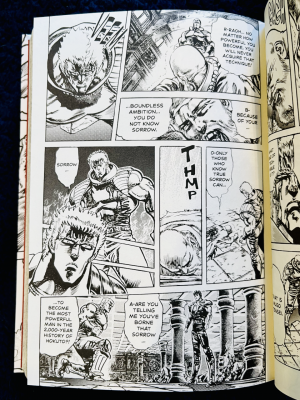Last night, I finished catching up on Fist of the North Star, after being a few volumes behind. Viz’s kanzenban edition wraps up the first massive arc in Vol. 10, then the second starts with a timeskip in Vol. 11. Vol. 10 closes out with main character Ken (aka Kenshiro) facing off against his greatest rival and Hokuto brother, Raoh (aka Kenoh).
 There’s quite a bit from Raoh’s point of view. Here, the reader learns that Raoh’s fear of Ken stems from the latter’s sorrowful eyes. Ken’s sorrow is shown to be the source of his strength, and the reason why he was chosen as the successor to the deadly assassination art of Hokoto Shinken. Raoh doesn’t understand either sorrow or love, which prevents him from obtaining the most powerful techniques and thus fuels his inferiority complex. His journey to become Ken’s equal leading up to their final battle is thus one of comprehension.
There’s quite a bit from Raoh’s point of view. Here, the reader learns that Raoh’s fear of Ken stems from the latter’s sorrowful eyes. Ken’s sorrow is shown to be the source of his strength, and the reason why he was chosen as the successor to the deadly assassination art of Hokoto Shinken. Raoh doesn’t understand either sorrow or love, which prevents him from obtaining the most powerful techniques and thus fuels his inferiority complex. His journey to become Ken’s equal leading up to their final battle is thus one of comprehension.
When I was a newbie anime fan in the early 90s, Fist of the North Star‘s reputation stemmed from its violence, with exploding heads and fountains of blood streaming from the remaining neck stumps. All of that is certainly here, and more dramatically effective than it may seem going by that simple description. Ken’s deadly acupressure often has a time delay component. He’ll strike a pressure point on an enemy, then start walking away. Said enemy will erupt in laughter, believing that Ken isn’t all that. Ken whips around, points at the enemy, then delivers his epitaph, “You are already dead.” Cue exploding head, or torso, or entire body.
Such scenes are the hooks to draw readers in. What has kept me here is Ken’s stoic compassion, his personal tragedies, and the assortment of friends and rivals who emerge throughout. Key amongst them are Bat and Rin, a boy and girl who serve as the reader proxies and accompany Ken nearly everywhere. At the end of Vol. 10, it’s their voluntary separation from Ken which gives this arc its true finality.
Rin is one of a small handful of girls and women who appear in Fist of the North Star, but isn’t the most important. That would be Yuria, the kind soul who grew up with Ken, Raoh, and their other “brothers” during their martial arts training. Yuria is the love of Ken’s life, and plays a central role early on, albeit in a stereotypical fashion. Other women don’t fare much better, mainly serving as people the men of the story wish to protect, though there is sometimes the likes of Mamiya, who is willing to fight back.
One thing that’s curious about this manga is that, throughout its post-nuclear hellscape, there are a number of people (and occasionally animals) that have become powerful giants, and they are almost always male. It’s never stated outright, but this gigantism seems to be a side effect of radioactive fallout, in addition to being a visual indicator of power. Sickness is the only other obvious symptom of radiation exposure, which leads to a different sort of drama.
Although there was one particular moment when I considered dropping the series entirely, the story made up for it with the very next volume. With Rin and Bat now grown up in Vol. 11, I’m sticking with it until the end. Fist of the North Star is certainly a product of its time, an era in Shonen Jump history which also gave us the beginnings of other classics like Dragon Ball, Jojo’s Bizarre Adventure, and Kimagure Orange Road. Ten years ago, I never would’ve thought I would enjoy this series as much as I have, nor would I have thought it as nuanced as it actually is at times. For all of its ultraviolence, Fist of the North Star is also tender and moving. Ken’s tears are as powerful as his fists, and his smiles, on the rare occasions that they happen, make all of the previous pages of blood and guts and agony and despair worth it.